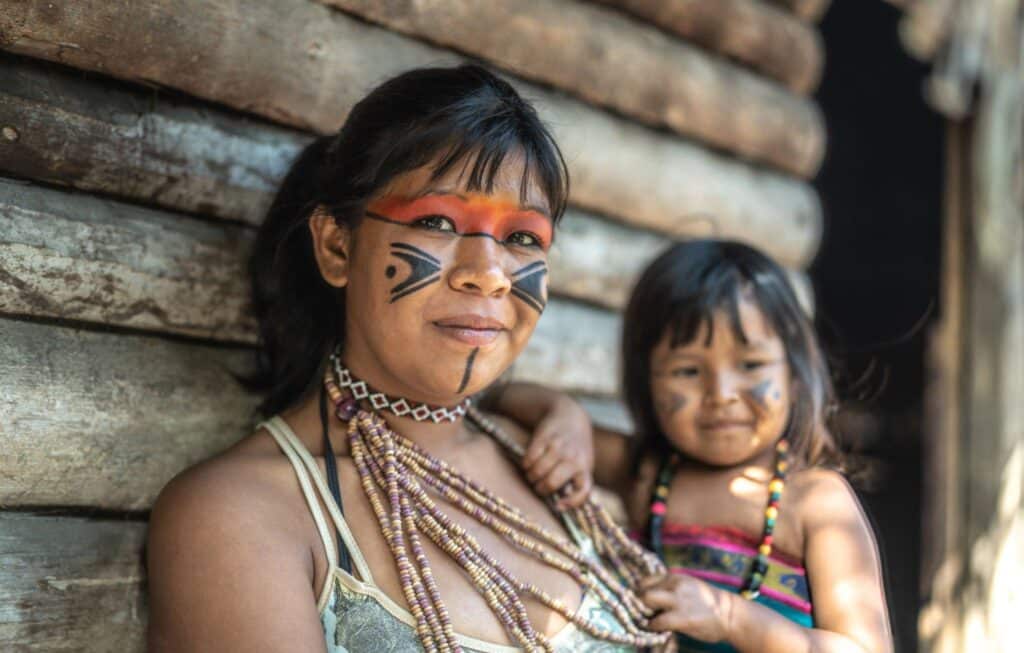Ethnic tourism is tourism motivated primarily by the desire to encounter and learn about distinctive, traditional ethnic and indigenous cultures. In other words, ethnicity itself is the key tourist attraction.
Indigenous tourism is sometimes distinguished specifically as ethnic tourism where ‘indigenous people themselves operate tours and cultural centres, provide visitor facilities and control tourist access to cultural events and homelands’
Some regions of the world are home to indigenous ethnic groups which have maintained their own distinctive cultures and traditional ways of life – usually protected from modernisation and Westernisation by remoteness or inaccessibility.
Tour operators see traditional, exotic cultures as a unique tourism resource for a specialised form of cultural tourism known as ethnic tourism or ‘discovery tourism’. Where this is managed by indigenous people themselves, it may be called indigenous tourism or ‘aboriginal tourism’ (particularly in Australia). Such tourism gives tourists the opportunity to experience remnants or replicas of cultural life –
whether in native habitations, or in cultural precincts/centres and theme parks.
Indigenous cultural tourism (or indigenous themed tourism) is cultural tourism focused on an indigenous culture, site or experience (which may also involve indigenous ownership or partnership, emphasising authenticity, cultural maintenance and self-determination).
Diversified indigenous tourism comprises tourism ventures controlled by indigenous people, but which do not have culture as their sole or main theme. Examples include resorts, cruises, campgrounds, visitor services and even (in the case of some Native American reservations) casinos.
Indigenous cultural tourism gives tourists the opportunity to encounter and learn about unique traditional cultures: to witness or participate in their daily life, religious rituals, meals, customs, music and dancing and so on.
Meaning of Ethnic Tourism

The term “Ethnic” was originally coined to refer to all those groups which were not
Jewish. By mid-15th Century all non-Jewish and Non-Christian groups were termed
“Ethnic”. By the late 19th and early 20th Century, “Ethnicity” was placed between the
ideas of race and those of culture.
Ethnic Tourism signifies the tourists’ interests in the customs of the indigenous and exotic peoples. It is a form of special interest tourism as different from general tourism which focuses directly on the local people. It involves intimate contacts with the .”authentic” indigenous culture.
In this form of tourism, the tourist visits the homes of the local people,
observes and participates in their festivals, dances, rituals and other forms of cultural expressions. Human contacts with the indigenous people become very important in this form of tourism and it involves a study and purchase of local products as well.
Differences Between Ethnic and Cultural Tourism
To many people, these two forms of tourism may appear similar. But they are different in content. It is, therefore, necessary to emphasize the differences between them so as to make you aware that the tourist’s interests in both cases may be at variance with each other.
In Ethnic Tourism the tourist is interested to have a direct contact with the local people. He/She wants a first-hand experience with the way of life and cultural artifacts of the people who are being visited.
In Cultural Tourism,’ however, the contact with people is indirect. The tourists’ main interest is not direct exposure to and involvement with the traditional cultural practices of the locals. It is viewing the culture, not experiencing it.
Thus, while in Ethnic Tourism, the tourist seeks more “intimate” and “authentic” contact. In Cultural Tourism, the contact with the indigenous people is not so direct.
Positive Effects of Ethnic Tourism
Ethnic Tourism plays an important role in the tourism sector. There are various positive effects of ethnic tourism. Let’s discuss them:
Economic Benefits: Economic benefit accruing to the inhabitants, middlemen and the country as a whole is the same as happens in other forms of tourism. More
employment. higher income, improved standard of living etc. are some of the
benefits. However, most of these benefits go to the people who are outside the ethnic groups visited by the tourists.
Cultural Revitalization: In many instance Ethnic Tourism helps revive the local
people’s interest and pride in their cultural traditions and values. The homogenizing
influence of mass media and the hegemonic culture generally tend to push the local folk traditions into oblivion.
The onslaught of western culture through films. videos, audios and newspapers force the diverse cultural patterns on to the backstage where they survive merely as occasional ritual expressions.
In Ethnic Tourism, however, the emphasis is directly on the traditional cultural forms. The tourists seek to observe/participates in the local festivals and other celebrations. The stress is on the peculiarities of local culture as opposed to the imposing dominance of the homogenizing culture. All this revives the interest of local people in their own cultural traditions
Negative Effects of Ethnic Tourism
Ethnic Tourism has folk traditions as its basis. But the problem starts when the local culture itself is treated as a commodity.
Commoditization, i.e., the treatment of things in marketable terms, is a general feature of the tourism industry. The travel agents and tour operators, in order to draw more and more tourists, try to turn all the products of local culture into marketable commodities.
Local dresses, toys, potteries, architecture, idols, religious rituals, cultural festivals and feasts arc all conceived as saleable things. Advertisements and brochures are issued drawing the tourists’ attention to the placing of these cultural artefacts on the counter for sale.
The local people arc paid to perform and enact for the tourists. The tourists and the
local people are turned into buyers and sellers respectively in a competitive cultural market.
Even the nuances of life-style are appropriated in tourism packages for sale to the
tourists. If this kind of cultural denigration goes on unchecked. it can prove destructive to the local culture and people. The treatment of culture as commodity over which the tourists can claim rights negates the right of the people to their own culture.
In Ethnic Tourism, the local people do not simply serve the tourists. Instead the hosts themselves are “on show”. The tourists desire that the locals be presented to them in their ethnic dresses and costumes, perform their ethnic dances, indulge in their ceremonies and organise their festivals for the tourists who can then observe them, photograph and taperecord them, and even participate in local functions.
The tourist’s desire to find the “authentic” and “original”, the role of the local people as “living spectacle” and the modernising and homogenising influence of the tourists on the locals create a peculiar situation in which the more is the tourist’s demand for the “authentic”, the more he gets is the staged.
Attractions and Motivations for Ethnic Tourism

Ethnic or indigenous tourist attractions include: cultural museums, display villages and theme parks; indigenous cultural festivals, arts and crafts; special events (such rituals, sports events and gatherings such as ‘corroborees’ or ‘powwows’); and education about the cultural, environmental and spiritual aspects of indigenous heritage.
Interest in indigenous and traditional cultures usually focuses on the ‘four
Hs’ (habitat, heritage, history and handicrafts) and indigenous knowledge of culture and nature.
The key motivators for ethnic and indigenous tourism overlap with those of adventure and educational tourism, since there are strong elements of each of these involved. However, the primary motivation is the potential for cultural interact between tourist and host. Underlying factors may include:
- The search for new experiences by tourists bored by mainstream tourism products, for added stimulation and intensity, and a higher ‘experiential’ component.
- Increasing disenchantment with the materialism of consumer cultures: the desire to escape from urban living and the search for meaning through encounters with the wisdoms and traditions of older cultures (particularly those associated with a deep relationship with the natural world).
- Increasing exposure to the concept of self-development (eg through higher education and the media), leading to the desire to learn something new while on holiday.
- Growing concern at cultural convergence and globalization, and the vulnerability of traditional cultures: indigenous lifestyles in their native settings may be on a list of ‘last chance to see’ attractions.
- Status and aspiration, due to the rarity and difficulty value (and perhaps moral connotations) of indigenous tourism experiences.